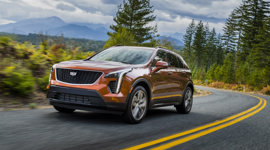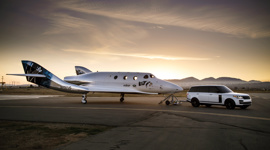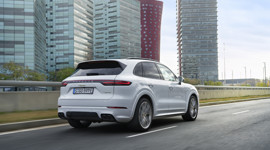As announced at this year’s Frankfurt auto show, the most polarizing product in the Porsche line-up is back for a third generation and is unquestionably here to stay. In fact, the performance marque is throwing a decent chunk of its playbook at the new 2019 Cayenne by incorporating some technologies that are likely to please its fans and may even win over some naysayers.
Some of the features are Porsche firsts, and others are adaptations of concepts used in the marque’s sports cars. Some will make a difference in drivers’ enjoyment of the vehicle on our roads, while a few are more meant for Germany’s Autobahns and aren’t likely to make much of a difference to most owners here in Canada.
Here’s a closer look at five highlights from the new Cayenne’s bag of tricks.
Adaptive Roof Spoiler

This feature is a world-first and is at the top of the list of the coolest things about the new Cayenne. But before we get you all excited, we need to start with some caveats: like the trick articulating wing on the new Panamera, this feature is only available on the top-tier Cayenne Turbo model; and much of its actual usefulness starts to come into play at around 160 km/h, so unless you’re planning to track your SUV, this spoiler doesn’t add much benefit to Canadians driving within the bounds of legality.
That said, it’s still pretty neat.
The spoiler articulates via an electric motor and a pair of hydraulics, and it has five working modes. Its starting flat position is where it sits when the vehicle is below 160 km/h, though this default position still adds 46 mm in length and sits 16.5 mm lower at its back edge than the spoiler on the new Cayenne and Cayenne S.
Once your speed gets above 160 km/h, the spoiler lifts by six degrees into the second position for a change in rearward height of 20 mm, which works to increase downforce load into the rear axle and improve rearward grip.
The third position is activated when the driver switches into Sport Plus mode, which as in other Porsche products is integrated with the optional Sport Chrono package. This moves the spoiler to a 12.6-degree angle to lift the back edge another 20 mm, which Porsche engineers say is the ideal height for gluing the rear tires to the road in the twisty bits.
The fourth position works in concert with the panoramic roof by lifting to 19.9 degrees at speeds over 160 km/h when the roof is open, which helps balance out the resulting air turbulence.
In the highest position, the spoiler acts as an air brake. When the driver hits the brake pedal from speeds between 170 and 270 km/h, the spoiler moves to 28.2 degrees to maximize downforce on the rear axle and improve stability. From a speed of 250 km/h, Porsche says this feature reduces the Cayenne’s stopping distance by up to two metres.
In everyday driving, of course, most Canadians will never come close to using any of this functionality. The most important part of the feature from our perspective is that there’s a button on the centre console that lets you move the spoiler into the third position manually so that you get to show it off to your friends and fellow road users.
Adaptive Radiator Shutters
These aren’t strictly new to the Cayenne with this generation, but the extent of their use is. While the outgoing generation had one set of shutters, all of the upcoming new models have four sets of shutters positioned behind the grille: one set of five that runs horizontally directly in front of the engine compartment, which carries over from the previous design; one single flap in the intake just above the front skid plate; and two sets of five flaps that are installed vertically behind each of the side air intakes to create an air curtain around the front wheels.
Each of these structures can open and close completely and can operate independently based on cooling needs. On Canadian roads, where temperatures are generally lower and the Cayenne isn’t likely to be pushed very hard, these will remain closed most of the time. This will work to reduce drag, which is good news for us from the standpoint of using less fuel and therefore bringing costs down at the pumps.
Staggered tires
 Porsche has been installing wider tires on the rear axles of its sports cars for decades, but with this new generation of Cayenne, the marque’s largest SUV will ship with staggered tires for the first time.
Porsche has been installing wider tires on the rear axles of its sports cars for decades, but with this new generation of Cayenne, the marque’s largest SUV will ship with staggered tires for the first time.
The standard tires on the Cayenne and Cayenne S are 19 inches and are 20 mm wider at the rear (255/55 front, 275/50 rear to be precise), and the optional 20-inch sets increase that offset to 30 mm (275/45 front, 305/40 rear). The Cayenne Turbo comes with a standard set of 21-inch tires that also carry a difference of 30 mm (285/40 front, 315/35 rear).
This might seem on its face to be a bit of overkill on a car that comes fitted with all-wheel drive, which all of the new Cayenne models do as the standard and only option. However, between the staggered tires, the new spoiler described above, and a recalibrated all-wheel drive system that’s not only capable of sending 100 percent of torque to the rear wheels but is now configured to do so more often, Porsche has thrown a lot of effort into giving the new Cayenne a drive character that’s more closely matched with its top performance models. It’s impossible to say for ourselves whether it works until we can drive it, but on paper it all looks promising.
Rear-Axle Steering
On the new Cayenne, rear-axle steering is available as an option for the first time. At speeds of up to 80 km/h it sends the rear wheels in the opposite direction from the fronts, and at higher speeds it steers both axles in the same direction up to a maximum of three degrees on the rear tires. When equipped, it takes the car’s turning circle from 12.1 metres down to 11.5. We’re not talking 911 levels of precision here, but it should add some dynamism and stability on winding roads.
Tungsten Carbide-Coated Brakes

Another Porsche first that will land with the new Cayenne is the new surface-coated brake, which falls between the base cast-iron brake and the available carbon-ceramic brake in terms of performance standards. This new brake is now standard equipment on Turbo models while being available as an option on the Cayenne and Cayenne S.
The new brake discs are still made of cast iron in the centre but are coated with tungsten carbide. Porsche’s engineers say this not only delivers better braking performance, higher fade stability, and a 30 percent longer service life, but it also reduces brake dust to almost zero and gives the discs a polished finish after a few hundred kilometres of use – meaning you can enjoy pretty, shiny brake discs instead of sneering at rusty ones.
A Few More Things of Note
The same three-chamber air suspension that was introduced on the latest Panamera is making its way into the Cayenne with the next generation. This system holds 40 percent more air than the former single-chamber unit and allows for a wider range of spring rates. It comes standard in the Turbo and is an option in the other models.
An 84-pixel light beam is integrated in the new Cayenne’s headlamps that’s self-calibrating and can deactivate in segments to avoid shining directly at oncoming drivers and reduce glare off approaching objects. This technology can’t yet be used in Canada due to restrictive regulations, but new Cayennes will ship to us with the same headlamps installed but the added functionality disabled. This means that, in theory, should the regulations ever be updated it will technically be possible to enable it.

The optional new emergency stop feature is an interesting one. If the car detects that the driver has stopped giving inputs, whether it’s due to a lack of attention or a medical emergency, it will sound an audible warning and then jerk the brake a few times (while taking into account surrounding traffic to avoid a collision). If the driver still doesn’t respond, the Cayenne brings itself to a stop within the lane where it’s operating and initiates a 911 call.
The 2019 Cayenne will start at $75,500, the Cayenne S at $92,600, and the Cayenne Turbo at $139,700. All three models arrive in Canada next summer.
























